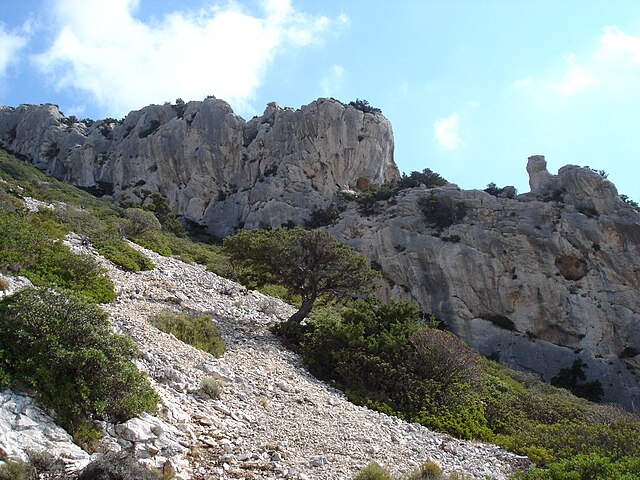Paleo-Sardinian language
Extinct language isolate indigenous to the island of Sardinia From Wikipedia, the free encyclopedia
Extinct language isolate indigenous to the island of Sardinia From Wikipedia, the free encyclopedia
Paleo-Sardinian, also known as Proto-Sardinian or Nuragic, is an extinct language, or perhaps set of languages, spoken on the Mediterranean island of Sardinia by the ancient Sardinian population during the Nuragic era. Starting from the Roman conquest with the establishment of a specific province, a process of language shift took place, wherein Latin came slowly to be the only language spoken by the islanders. Paleo-Sardinian is thought to have left traces in the island's onomastics as well as toponyms, which appear to preserve grammatical suffixes, and a number of words in the modern Sardinian language.

You can help expand this article with text translated from the corresponding article in Italian. (December 2020) Click [show] for important translation instructions.
|
| Paleo-Sardinian | |
|---|---|
| Nuragic | |
| Region | Sardinia |
| Ethnicity | Ancient Sardinians |
| Extinct | c. 2nd century AD[citation needed] |
| Language codes | |
| ISO 639-3 | None (mis) |
| Glottolog | None |
The Swiss linguist Johannes Hubschmid proposed six linguistic layers in prehistoric Sardinia.[1]
There is toponymic evidence suggesting that the Paleo-Sardinian language may have had connection to the reconstructed Proto-Basque and to the Pre-Indo-European Iberian language of Spain.[2] Eduardo Blasco Ferrer concluded that it developed in the island in the Neolithic as a result of prehistoric migration from the Iberian peninsula.[3] The author in his analysis of the Paleo-Sardinian language finds only a few traces of Indo-European influences (*ōsa, *debel- and perhaps *mara, *pal-, *nava, *sala), which were possibly introduced in the Late Chalcolithic through Liguria.[4] Similarities between Paleo-Sardinian and Ancient Ligurian were also noted by Emidio De Felice.[5] According to Max Leopold Wagner:
So eg. sakkáyu, -a, sakkaggu, -a is in Sardinian a lamb or a goat of a year or a year and a half; brings to mind the Aragonese segalo, Catalan sugali, Béarnese sigàlo «goat of the same age», which my colleague Rohlfs combined with the Basque seguila «chèvre d'un an» which seems to be derived from the Basque seliail, segai! «svelte», safaildu «décharner, maigrir». Of course, not everything is equally certain, and the investigation must be continued and expanded. Naturally I am far from wanting to identify Sardinians and Basques, Sardinians and Iberians, I believe that one must always bear in mind that other influences may also have manifested themselves, long-standing Mediterranean influences, Ligurian and perhaps even Alpine influences. Certain coincidences between Sardinian and Albanian are also notable"
— Max Leopold Wagner, Osservazioni sui sostrati etnico-linguistici sardi, 1933[6]
Bertoldi and Terracini[citation needed] propose that the common suffix -ara, stressed on the antepenult, was a plural marker, and they indicated a connection to Iberian or to the Paleo-Sicilian languages. Terracini claims a similar connection for the suffix -ànarV, -ànnarV, -énnarV, -ònnarV, as in the place name Bonnànnaro. A suffix -ini also seems to be characteristic, as in the place name Barùmini. A suffix or suffixes -arr-, -err-, -orr-, -urr- have been claimed to correspond to the North African Numidia (Terracini), to the Basque-speaking Iberia and Gascony (Wagner, Rohlfs, Blasco Ferrer, Hubschmid), and to southern Italy (Rohlfs).
The non-Latin suffixes -ài, -éi, -òi, -ùi survive in modern place names based on Latin roots. Terracini sees connections to Berber. Bertoldi sees an Anatolian connection in the endings -ài, -asài (similar claims have been made of the Elymians of Sicily). A suffix -aiko is also common in Iberia. The tribal suffix -itani, -etani, as in the Sulcitani, has also been identified as Paleo-Sardinian.
The linguist M. Pittau[7] argues that the Paleo-Sardinian ("Sardian") language and the Etruscan language were closely linked, as he argues that they were both emanations of the Anatolian branch of Indo-European. According to Pittau, the "Nuragics" were a population of Lydian origin who imported their Indo-European language to the island, pushing out the Pre-Indo-European languages spoken by the Pre-Nuragic peoples.
Some examples of Nuragic names of Indo-European origin might be:[8]

Archeologist Giovanni Ugas suggested that the three main Nuragic populations (Balares, Corsi and Ilienses) may have had separate origins and so may have spoken different languages:
The common subdivision of modern Sardinian into the three dialects of Gallurese, Logudorese and Campidanese might reflect that multilingual substratum.[12] Other Paleo-Sardinian tribes of possible Indo-European stock were the Lucuidonenses from the north of the island, who might have been originally from Provence, where the toponym Lugdunum is attested, and the Siculensi, perhaps related to the Siculi from Sicily, from the Sarrabus region.[13]

According to Guido Borghi, researcher of glottology and linguistics at the University of Genoa, conclusions appear to display the merits of both Proto-Indo-European and pre-Indo-European/non-Indo-European theories in Sardinian toponyms. Proto-Indo-European appellations can be recognized in Paleo-Sardinian, as in the case of the toponym *Thìscali, which could derive from the Proto-Indo-European *Dʱĭhₓ-s-kə̥̥̆ₐ-lĭhₐ with the meaning of "the little (mountain) in the set of the territories which are in plain sight".[14]
Seamless Wikipedia browsing. On steroids.
Every time you click a link to Wikipedia, Wiktionary or Wikiquote in your browser's search results, it will show the modern Wikiwand interface.
Wikiwand extension is a five stars, simple, with minimum permission required to keep your browsing private, safe and transparent.